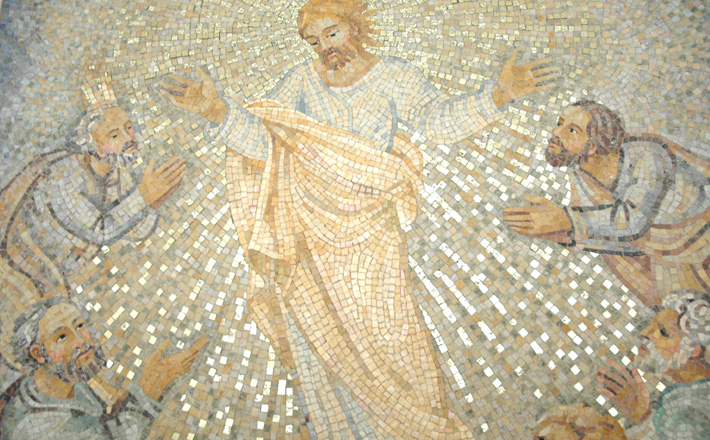Commentary on 2 Peter 1:16-21
The Revised Common Lectionary provides only two chances to preach from 2 Peter.
This passage presents the preacher with intriguing opportunities to reflect on the meaning of the Transfiguration story, particularly with regard to how God continues to communicate in the world.
This text is intended to counteract the claim being made by some that the promise of Jesus’ return was invented by the apostles. Opponents of the author may have been claiming that the apostles made up the story of Jesus’ return to instill fear and thus control behavior. This was a common critique made by Greek and Roman philosophers about the ancient myths regarding the gods. There is a stream of New Testament scholarship which has made a similar claim, suggesting that a historically non-apocalyptic Jesus was followed by a church which composed an apocalyptic message to shore up the authority of its early leaders.
Regardless of whether we find that suggestion persuasive either historically or theologically, this text will raise questions about the apocalyptic claims of Scripture and the church. What do we do with the promise of Jesus’ final coming when the world continues to roll on for so long without any obvious divine disruption? Have we simply been misled, and our hope merely a “cleverly devised myth” (verse 16)? An honest look at the daily events in the world might draw us toward that conclusion.
In response, the author summarizes the story of Jesus’ Transfiguration, claiming the role of an eyewitness. The author introduces the Transfiguration as an event with which the readers will be familiar; this is a story that the church has been telling for a very long time, and so it needs no introduction. It does, however, need interpretation. Perhaps what is most significant in the author’s brief summary is the lack of attention given to the visible aspects of the event.
Despite claiming to be an “eyewitness,” nothing is said here about what was seen. There is no attention paid to those visible aspects that are so striking in the Gospel accounts: Jesus’ shining face, his dazzling clothing, Moses and Elijah standing with him, the overshadowing cloud. Instead, the focus is squarely on what was heard. God’s glory was given to Jesus not by Jesus’ appearance being changed (“transfigured”), but rather by what God declares about Jesus.
The words from heaven do not differ significantly from what we hear in Matthew’s Transfiguration story. It is worth noticing, however, that 2 Peter describes the location as being “on the holy mountain” (verse 18). While that could simply mean that the church had begun to think of the place, whichever hill it might have been, as “holy” because of this event, the phrase has deeper scriptural resonances.
“The holy mountain” is a common description of Zion, the holy hill of Jerusalem, as the place which God chose for God’s own presence and for God’s royal rule through the anointed king. It is not accidental, then, that the words from heaven include an allusion to Psalm 2, a coronation psalm for Israel’s king. By focusing on these words and setting aside the visual elements of the familiar story, the author of 2 Peter directs the readers to Jesus’ identity as the one who rules in God’s name.
Here, the Transfiguration is not directly about Jesus’ identity in terms of a divine nature (as might be concluded from the more visual aspects of the story), but about the role given to Jesus by God as the eschatological ruler. Here, the Transfiguration is not a foreshadowing of Jesus’ resurrection, as has often been suggested in study of the Gospels’ Transfiguration stories. Rather, 2 Peter highlights Christ’s role as God’s promised ruler for the world (see also Matthew 16:28, which leads readers into the account of the Transfiguration with similar expectations in mind by referring to “the Son of Humanity coming in his kingdom”). The honor, glory, and love declared about Jesus at the Transfiguration prefigures what he will bring for the world when he comes. It is in that confident hope that the church continues to live.
The “prophetic message” referred to in verse 19 is probably not a reference to a specific passage or even to prophetic material in a strict sense, but rather to all of Scripture. The claim here is that the apostles based their proclamation on Scripture (as faithful preaching still does!), and not only on their own experience. The text’s movement from recalling the Transfiguration to claiming that the Scripture is now “more fully confirmed” could be taken as a basis for seeking certain experiences or historical events which would “prove” the truth of Scripture. That would be a misunderstanding of 2 Peter’s argument.
Instead, Scripture as a whole points us not to proofs and signs, but to Jesus himself as God’s coming King, as God’s promise for the world. The author claims that this way of hearing Scripture coheres with the apostles’ own experience, but its truth does not depend on that experience. We ourselves probably won’t hear voices booming from heaven, but our proclamation too is rooted in the conjunction between Scripture’s witness and what we have experienced: in the Word proclaimed, and in mercy received, and in God’s glory glimpsed in the midst of community and service to our neighbors.
God’s speech is the focus in the first part of this passage. At the end, the author returns to consider again how God has spoken, this time as the Spirit moved the writers of Scripture. From beginning to end, then, this is a text centered on the claim that God addresses us, first in Jesus, and then in Scripture read and proclaimed as pointing to Jesus. Isn’t that what we still hope, and in our more courageous moments even believe? In preaching the gospel, in speaking for justice, in words of comfort and love and shared pain, we too are being carried along by the Spirit, not into our own private, idiosyncratic viewpoints, but into the dawning light of God for the world.


February 26, 2017